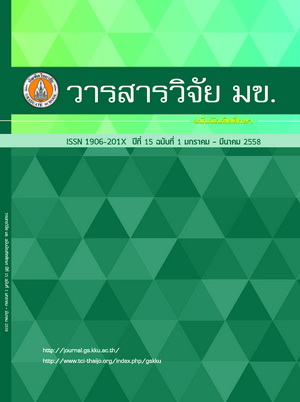การประเมินการแพร่ระบายก๊าซมีเทนโดยวิธี Default, First Order Decay และโปรแกรม LandGEM จากสถานที่ กำจัดขยะมูลฝอยแบบเทกองที่มีการควบคุม : กรณีศึกษาพื้นที่เทศบาลเมืองนครพนมจังหวัดนครพนม (Determination of Methane Potential by Default Method, First Order Decay
Keywords:
Landfill gas, Greenhouse gas, Controlled dump, Methane emissionAbstract
งานวิจัยนี้มีวัตถุประสงค์เพื่อคาดการณ์การแพร่ระบายก๊าซมีเทนที่เกิดจากสถานที่กำจัดขยะมูลฝอยแบบศูนย์รวมกำจัดขยะมูลฝอยเทศบาลเมืองนครพนม จังหวัดนครพนมโดยวิธีการคำนวณด้วยแบบจำลองทางคณิตศาสตร์ คือ1)วิธี default ของ IPCC 2) วิธีปฏิกิริยาลำดับที่ 1 ของ IPCC และ 3) โปรแกรม LandGEM ของU.S.EPA ผลการศึกษาพบว่าค่าที่คำนวณตามวิธี default ของ IPCC มีค่าสูงสุด รองลงมาคือ วิธีปฏิกิริยาลำดับที่ 1 ของ IPCC และโปรแกรม LandGEMของ U.S.EPA โดยพื้นที่บ่อฝังกลบที่ 1 มีอัตราการแพร่ระบายรวมเท่ากับ 117,138 58,023 และ 40,005 ตันคาร์บอนไดออกไซด์ต่อปี ตามลำดับและจากการคาดการณ์บ่อฝังกลบที่ 2 พบว่าอัตราการแพร่ระบายรวมเท่ากับ 176,757 77,196 และ 33,978 ตันคาร์บอนไดออกไซด์ต่อปี มีลักษณะการแพร่ระบายเช่นเดียวกับ บ่อฝังกลบที่ 1 โดยปริมาณก๊าซเพิ่มขึ้นตั้งแต่เริ่มฝังกลบมูลฝอยและจากกราฟปริมาณการแพร่ระบายก๊าซมีเทนจากพื้นที่ศูนย์กำจัดมูลฝอยรวม เทศบาลเมืองนครพนมบ่อที่ 1 และ 2 ด้วยวิธี default ของIPCCเท่านั้นที่แตกต่างจากแบบจำลองอื่นมาก ค่าการคาดการณ์การแพร่ระบายก๊าซมีเทนโดยวิธี FOD ของIPCCและ LandGEM มีค่าใช้ได้แตกต่างกันมากข้อกำจัดของการศึกษานี้เนื่องจากการศึกษาครั้งนี้ใช้แบบจำลองทางคณิตศาสตร์เพื่อให้สามารถทำการประเมินปริมาณก๊าซที่เกิดขึ้นจากสถานที่ฝังกลบขยะ ควรมีการใช้เครื่องมืออื่นๆในการตรวจวัดเพิ่มเติม เช่น flux chamber เพื่อให้สามารถตรวจวัดค่าก๊าซใกล้เคียงค่าที่แท้จริงและหากมีการดำเนินงานจริงควรวัดปริมาณและองค์ประกอบของก๊าซจากพื้นที่ฝังกลบอีกครั้ง
ABSTRACT
The objective of this research was to estimate methane emission from a controlled dump site in Nakhonphanom Municipality, Nakhonphanom Province in northeast Thailand. Currently, the site is a controlled dump site with possible plans to convert to a sanitary landfill. Three mathematical models were used: 1)the Default Method from the Intergovernmental Panel on Climate Change (IPCC),2) the First-Order Decay Method from the IPCC (IPCC version 02, October 2007), and 3) the Land Gas Emission Model Program (LandGEM version 3.02, May 2005) The resultsof methane emission evaluated by mathematical models were found that the mean value calculated based on the Default Method was the highest, followed by the IPCC, First-Order Decay Method, and the U.S.EPA LandGEM totaling117,138, 58,023, and 40,005 tones carbon dioxideequivalent., inwaste disposal site 1. And everage methane emission emitted fromwaste disposalsite 2, estimated methane productionrates totaling 176,757, 77,196, and 33,978 tones carbon dioxide equivalent. Which ofmethane emission evaluated likewisewaste disposal site 1 by increasingthe amount of gasfromlandfillwaste, andgraph Methane Emission from waste disposal Nakhon Phanomsite 1 and 2. The Default Methodof the IPCC is very different from other models. The predictions of methane emission by FODMethod of the IPCC and is available LandGEM very different. Limitations of the study include the use of modeling methods intended for closed landfills, which is not yet the case. Future studies should collect other information, such as a flux chamber for measuring gas closer to the true value. Landfill operators should perform long-term surveillance of the amount and composition of the gas from the landfill.



